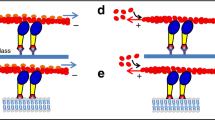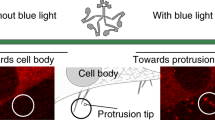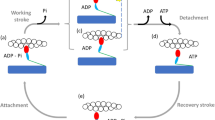Abstract
All members of the diverse myosin superfamily have a highly conserved globular motor domain that contains the actin- and nucleotide-binding sites and produces force and movement1,2. The light-chain-binding domain connects the motor domain to a variety of functionally specialized tail domains and amplifies small structural changes in the motor domain through rotation of a lever arm3,4. Myosins move on polarized actin filaments either forwards to the barbed (+ ) or backwards to the pointed (- ) end5,6. Here, we describe the engineering of an artificial backwards-moving myosin from three pre-existing molecular building blocks. These blocks are: a forward-moving class I myosin motor domain, a directional inverter formed by a four-helix bundle segment of human guanylate-binding protein-1 and an artificial lever arm formed by two α-actinin repeats. Our results prove that reverse-direction movement of myosins can be achieved simply by rotating the direction of the lever arm 180°.
This is a preview of subscription content, access via your institution
Access options
Subscribe to this journal
Receive 51 print issues and online access
$199.00 per year
only $3.90 per issue
Buy this article
- Purchase on Springer Link
- Instant access to full article PDF
Prices may be subject to local taxes which are calculated during checkout



Similar content being viewed by others
References
Toyoshima, Y. Y. et al. Myosin subfragment-1 is sufficient to move actin filaments in vitro. Nature 328, 536–539 (1987)
Manstein, D. J., Ruppel, K. M. & Spudich, J. A. Expression and characterization of a functional myosin head fragment in Dictyostelium discoideum. Science 246, 656–658 (1989)
Rayment, I. et al. Structure of the actin-myosin complex and its implications for muscle contraction. Science 261, 58–65 (1993)
Berg, J. S., Powell, B. C. & Cheney, R. E. A millennial myosin census. Mol. Biol. Cell 12, 780–794 (2001)
Wells, A. L. et al. Myosin VI is an actin-based motor that moves backwards. Nature 401, 505–508 (1999)
Homma, K., Yoshimura, M., Saito, J., Ikebe, R. & Ikebe, M. The core of the motor domain determines the direction of myosin movement. Nature 412, 831–834 (2001)
Kollmar, M., Dürrwang, U., Kliche, W., Manstein, D. J. & Kull, F. J. Crystal structure of the motor domain of a class-I myosin. EMBO J. 21, 2517–2525 (2002)
Veigel, C. et al. The motor protein myosin-I produces its working stroke in two steps. Nature 398, 530–533 (1999)
Prakash, B., Renault, L., Praefcke, G. J., Herrmann, C. & Wittinghofer, A. Triphosphate structure of guanylate-binding protein 1 and implications for nucleotide binding and GTPase mechanism. EMBO J. 19, 4555–4564 (2000)
Uyeda, T. Q., Abramson, P. D. & Spudich, J. A. The neck region of the myosin motor domain acts as a lever arm to generate movement. Proc. Natl Acad. Sci. USA 93, 4459–4464 (1996)
Anson, M., Geeves, M. A., Kurzawa, S. E. & Manstein, D. J. Myosin motors with artificial lever arms. EMBO J. 15, 6069–6074 (1996)
Ruff, C., Furch, M., Brenner, B., Manstein, D. J. & Meyhöfer, E. Single-molecule tracking of myosins with genetically engineered amplifier domains. Nature Struct. Biol. 8, 226–229 (2001)
Kliche, W., Fujita-Becker, S., Kollmar, M., Manstein, D. J. & Kull, F. J. Structure of a genetically engineered molecular motor. EMBO J. 20, 40–46 (2001)
Kull, F. J. & Endow, S. A. Kinesin: switch I & II and the motor mechanism. J. Cell Sci. 115, 15–23 (2002)
Vale, R. D. & Milligan, R. A. The way things move: looking under the hood of molecular motor proteins. Science 288, 88–95 (2000)
Furch, M., Geeves, M. A. & Manstein, D. J. Modulation of actin affinity and actomyosin adenosine triphosphatase by charge changes in the myosin motor domain. Biochemistry 37, 6317–6326 (1998)
Furch, M., Remmel, B., Geeves, M. A. & Manstein, D. J. Stabilization of the actomyosin complex by negative charges on myosin. Biochemistry 39, 11602–11608 (2000)
Van Dijk, J. et al. Differences in the ionic interaction of actin with the motor domains of nonmuscle and muscle myosin II. Eur. J. Biochem. 260, 672–683 (1999)
Knetsch, M. L. W., Uyeda, T. Q. & Manstein, D. J. Disturbed communication between actin- and nucleotide-binding sites in a myosin II with truncated 50/20-kDa junction. J. Biol. Chem. 274, 20133–20138 (1999)
Tsiavaliaris, G. et al. Mutations in the relay loop region result in dominant-negative inhibition of myosin II function in Dictyostelium. EMBO Rep. 3, 1099–1105 (2002)
Ponomarev, M. A., Furch, M., Levitsky, D. I. & Manstein, D. J. Charge changes in loop 2 affect the thermal unfolding of the myosin motor domain bound to F-actin. Biochemistry 39, 4527–4532 (2000)
Reubold, T. F., Eschenburg, S., Becker, A., Kull, F. J. & Manstein, D. J. A structural model for actin-induced nucleotide release in myosin. Nature Struct. Biol. 10, 826–830 (2003)
Ringler, P. & Schulz, G. E. Self-assembly of proteins into designed networks. Science 302, 106–109 (2003)
Kron, S. J. & Spudich, J. A. Fluorescent actin filaments move on myosin fixed to a glass surface. Proc. Natl Acad. Sci. USA 83, 6272–6276 (1986)
Lehrer, S. S. & Kerwar, G. Intrinsic fluorescence of actin. Biochemistry 11, 1211–1217 (1972)
Lorenz, M., Poole, K. J., Popp, D., Rosenbaum, G. & Holmes, K. C. An atomic model of the unregulated thin filament obtained by X-ray fiber diffraction on oriented actin-tropomyosin gels. J. Mol. Biol. 246, 108–119 (1995)
Dominguez, R., Freyzon, Y., Trybus, K. M. & Cohen, C. Crystal structure of a vertebrate smooth muscle myosin motor domain and its complex with the essential light chain: visualization of the pre-power stroke state. Cell 94, 559–571 (1998)
Schröder, R. R. et al. Three-dimensional atomic model of F-actin decorated with Dictyostelium myosin S1. Nature 364, 171–174 (1993)
Guex, N. & Peitsch, M. C. SWISS-MODEL and the Swiss-PdbViewer: an environment for comparative protein modeling. Electrophoresis 18, 2714–2723 (1997)
Herm-Götz, A. et al. Toxoplasma gondii myosin A and its light chain: a fast, single-headed, plus-end-directed motor. EMBO J. 21, 2149–2158 (2002)
Acknowledgements
We thank S. Zimmermann for excellent technical assistance, R. Fedorov for providing Fig. 1, H. Faulstich for providing rhodaminephalloidin, C. Herrmann for the hGBP-1 cDNA, R. S. Goody, K. C. Holmes, M. A. Geeves, F. J. Kull, R. Maytum and D. P. Mulvihill for comments and discussions, and K. C. Holmes for continuous support. The work was supported by grants from the Deutsche Forschungsgemeinschaft (to D.J.M.).
Author information
Authors and Affiliations
Corresponding author
Ethics declarations
Competing interests
The authors declare that they have no competing financial interests.
Supplementary information
41586_2004_BFnature02303_MOESM1_ESM.gif
Supplementary Figure: Graphical representation of the back and forth movement of four actin filaments on a lawn of non-specifically adsorbed E698-WΩ2R. (GIF 17 kb)
41586_2004_BFnature02303_MOESM2_ESM.mov
Supplementary Movie 1: Molecular model of an artificial pointed (-) end directed myosin motor that is attached in the ‘pre-power-stroke’ state to an actin protofilament consisting of five actin monomers (green and blue). The motor is created by fusing three pre-existing molecular building blocks: a class-I myosin motor domain (grey), a directional inverter formed by a segment of human guanylate binding protein-1 (red), and an artificial lever arm formed by two α-actinin repeats (orange). (MOV 1426 kb)
41586_2004_BFnature02303_MOESM3_ESM.mov
Supplementary Movie 2: Actin-filaments move with their pointed (-) ends leading, on surfaces that are coated with HMM. (MOV 776 kb)
41586_2004_BFnature02303_MOESM4_ESM.mov
Supplementary Movie 3: Actin-filaments move with their pointed (-) ends leading, on surfaces that are coated with E698-2R. This result is in agreement with myosin II-derived motors moving towards the barbed (+) end. (MOV 236 kb)
41586_2004_BFnature02303_MOESM5_ESM.mov
Supplementary Movie 4: E698-Ω2R attached to an anti-His-tag antibody-coated surface moves filaments with their pointed (-) ends trailing, indicating that E698-Ω2R is a pointed (-) end directed motor. (MOV 615 kb)
Rights and permissions
About this article
Cite this article
Tsiavaliaris, G., Fujita-Becker, S. & Manstein, D. Molecular engineering of a backwards-moving myosin motor. Nature 427, 558–561 (2004). https://doi.org/10.1038/nature02303
Received:
Accepted:
Issue Date:
DOI: https://doi.org/10.1038/nature02303
This article is cited by
-
Optical control of fast and processive engineered myosins in vitro and in living cells
Nature Chemical Biology (2021)
-
Synthetic biology approaches to dissecting linear motor protein function: towards the design and synthesis of artificial autonomous protein walkers
Biophysical Reviews (2020)
-
Molecular dynamics simulation of the nanosecond pulsed electric field effect on kinesin nanomotor
Scientific Reports (2019)
-
Controllable molecular motors engineered from myosin and RNA
Nature Nanotechnology (2018)
-
Creating biomolecular motors based on dynein and actin-binding proteins
Nature Nanotechnology (2017)
Comments
By submitting a comment you agree to abide by our Terms and Community Guidelines. If you find something abusive or that does not comply with our terms or guidelines please flag it as inappropriate.



